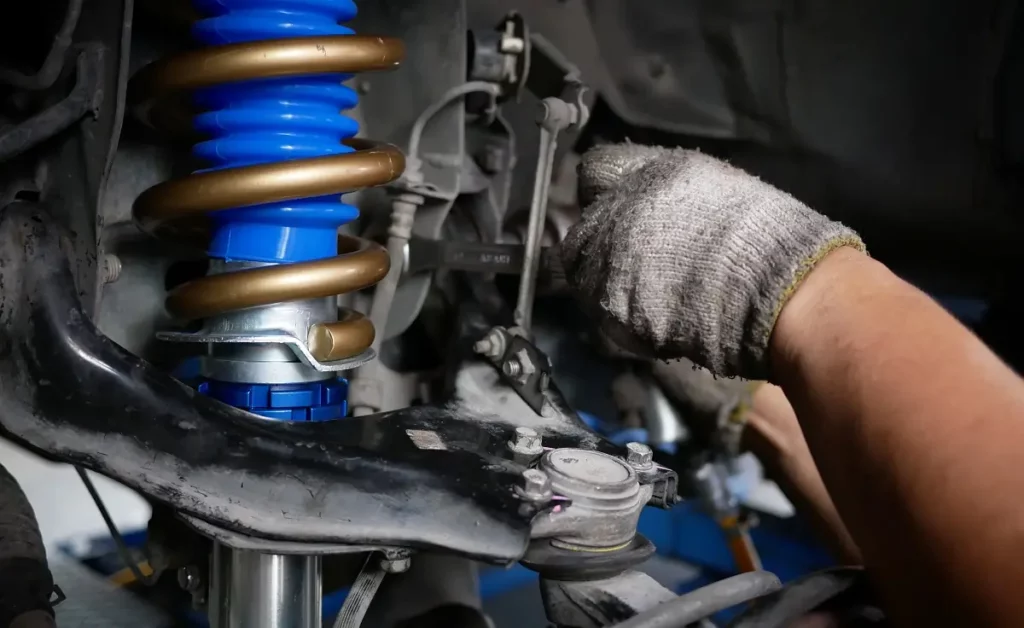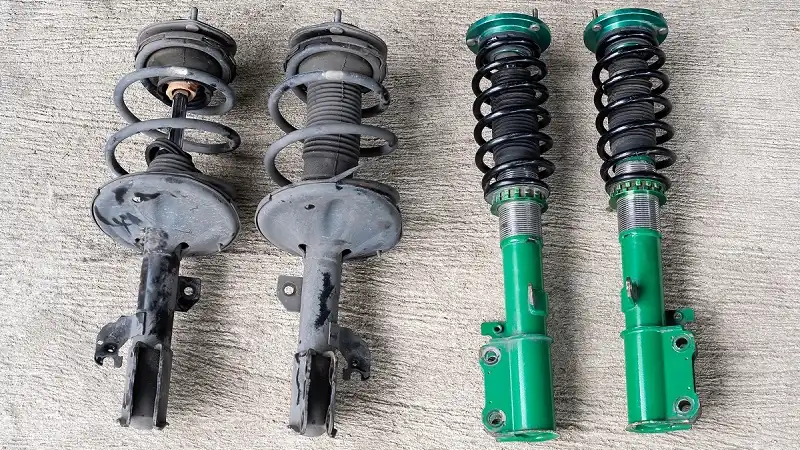When it comes to improving the stability or handling of your car, the suspension is the most crucial system you can upgrade. Investing in your suspension can produce a more predictable and responsive machine, directly translating to better lap times and a more engaging ride.
A good suspension setup also plays a huge role in maximizing the grip, ensuring that power produced by the engine is transferred to the ground in the most effective way possible. For this reason, the suspension setup is usually one of the first areas upgraded by someone looking to extract the most performance out of their car.
One of the go-to upgrades on the BMW E46 is to replace the stock shocks/springs with a coilover unit. Coilovers can be a great addition to your car’s performance package, but it’s worth noting that they’re not always the best solution. This guide covers everything you need to know about BMW E46 coilovers and will help you decide if it’s something you should invest in.

What Are Coilovers?
Coilovers get their name from the coil-over-shock design that they all share. Like the regular spring/shock combo, its job is to support the vehicle’s weight while absorbing bumps from the road and ensuring that all four wheels stay in contact with the ground.
However, the main difference here is that coilovers combine these two critical components into a single device. Furthermore, most coilovers give their users extra functionality in the sense that you can adjust the ride height, ride stiffness, and so on.
While the stock suspension setup in a car is oriented towards providing a plush and compliant ride, coilovers are typically sporty in nature. In the case of BMW E46 coilovers, most options available offer lots of room for adjustability; you can tweak ride height and compression and
rebound damping.
What Are The Different Types of E46 Coilovers?
Coilovers can be broadly classified into two — coilover sleeves and full coilovers. The coilover sleeve, as the name suggests, is a hollow tube that fits over an existing shock. They don’t offer as much adjustability as full-body units but are more capable than just lowering springs that solely reduce ride height.
When people mention coilovers, they usually refer to the full-body systems we’ll be talking about in this article. Depending on how much you pay for one, these can be further classified into different types.
Manually Adjusted E46 Coilovers
Most affordable E46 coilovers in the market fall under this category. They allow you to adjust ride height or spring preload but do not allow you to tweak suspension compression or rebound damping.
In most cases, you can adjust them by hand, making it a great starting point for someone just getting into the vast world of suspension tuning or track days. They’re also a choice for someone who isn’t going to be spending a lot of time on track.
Coilovers with Adjustable Rebound and Compression Damping
Coilovers that offer adjustable rebound and compression damping, in addition to the ability to tweak ride height, are the complete suspension package. You’ll need these if you want to extract the most out of your car. These kits are notably more expensive than the ones that offer only preload adjustability, but they give you the freedom to fine-tune the suspension as per your requirements.
You should consider investing in E46 coilovers with rebound and compression damping if you’re someone who is serious about tracking their car. They allow you to set the suspension up based on the track’s surface, camber, ambient conditions, and tire characteristics. .
Electronically Adjustable E46 Coilovers
With everything mentioned above, you have to manually adjust the springs to tune how they react. As the name suggests, electronically adjustable coilovers do this themselves. These kits can be hefty investments, but they’re worth the price if their sole purpose is to help you achieve the best track time possible.
Electronically adjustable coilovers are constantly adjusting the damping of your springs based on several continuously measured metrics. Some systems also allow you to register preset suspension settings that you can toggle between with just the twist of a dial.
What Are the Benefits of Giving Your E46 Coilovers?

Upgrading to coilovers can bring a multitude of improvements to your BMW E46. For starters, it will allow you to lower your car. Doing so lowers the center of gravity, reducing weight transfer when you’re going into a corner fast. This way, the weight is more evenly distributed, enabling maximum traction from your tires.
The same applies to when you accelerate or brake. A higher center of gravity would result in more weight transfer to the rear or the front, respectively, offsetting the balance of your car.
Another reason you might opt to give your E46 coilovers is the ability to fine-tune the suspension to meet your needs. Whether you’re tracking your car, or you just like to go out for a drive through the twisties, dialing-in a perfect suspension setup makes all the difference.
The features that an average coilover offers can vary depending on how much you are willing to spend on them. Top-end units will allow you to extensively adjust the ride height without altering the compression settings of the spring or the suspension travel. On the flip side, more affordable coilovers may not offer you much adjustability and may be restricted to only lowering the ride height of your E46.
Are E46 Coilovers Better than Springs?
If you’re looking to take your car to the track and improve your lap timings, a set of coilovers may be an investment worth looking into. However, if the vehicle predominantly finds itself on public roads, taking this route may not be the most sensible decision.
For starters, coilovers can drastically alter the ride of your Bimmer. You’ll lose that soft ride and comfort to achieve a stiffer, more responsive setup. As a result, you’re more likely to feel bumps on the road. Likewise, lowering your car with coilovers can also result in reduced suspension travel. If you run through a deep pothole or a significant bump in the road while running a lowered ride height setup, it can cause extensive damage to your suspension.
Ultimately, the decision to invest in coilovers comes down to what you’re looking to achieve with the upgrade. If you’re trying to improve your lap times around a racetrack, coilovers are one of the first parts you should be looking to upgrade your Bimmer with.
However, if the main reason behind your inclination to get coilovers is solely the aesthetics of a lowered ride height, you’ll be much better off getting sportier, stiffer springs from brands like Lesjofors, Bilstein, KONI, Eibach and others.
There’s also a middle ground between the two — improved suspension performance but not something that’s too stiff or sporty. In such a case, you can purchase several aftermarket springs and struts that will improve your suspension’s performance without reducing its ability to provide a comfortable ride.
Find Parts that Best Match Your Vehicle!
At the end of the day, coilovers may be an unnecessary update for many of us, and updating the OEM suspension with an aftermarket spring and strut setup may be all that’s needed.
At Bimmers.com, we’ve put together an extensive catalog of both suspension kits and individual parts. You can select from genuine OEM BMW parts or reputable aftermarket brands like Bilstein. Simply head to the shop section, input your car’s data, and search for the part you need!





